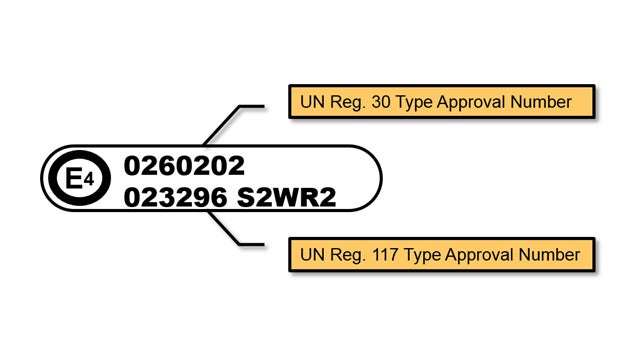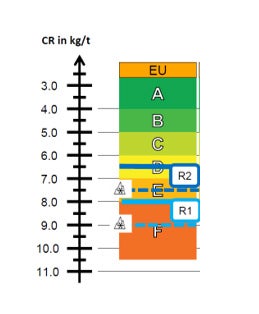
# Know-How
UN Regulation 117
Rolling Resistance and Rolling Noise Limits for Truck and Bus Tires
In 2009, the EU decided to introduce type approval for noise, wet grip, and rolling resistance according to UN regulation 117. A new “big E4 number” was added to the tire sidewall to signify type approval for UN regulation 117 replacing the smaller e4-S numbers stepwise.
External Rolling Noise: S1 or S2
Wet Grip: W*
Rolling Resistance: R1 or R2
* not mandatory in all cases

Every tire manufacturer must make sure that every tire sold in Europe and affiliated states falls within the sound and rolling resistance limit as defined in R117. Type Approval authorities issue the R117 certificate. This number will have to show on the tire’s sidewall including SxRx levels, e.g. as shown above “E4 023296 S2WR2”. See tables below for the stage 2 limits for truck and bus tires and for the introduction dates. All new Continental developments (incl. winter tires) after 11/2016 comply to “S2R2 / S2WR2”.
EU Tire Label Classes for Truck and Bus Tires
Tires that fulfil the R2 limit are labeled at least D, for winter tires marked with the Alpine-Symbol (3PMSF) an E label is still possible.
With introduction of R2 the minimum rolling resistance is raised by 20%. Continental tires that are labeled with C or better therefore have at least another 7.7% better rolling resistance performance than required by the new R2 type approval limit.

Continental Winter Tires
In wintry weather conditions Continental recommends fitting winter tires on all axles of trucks and buses, since standard tires reach their limits very quickly. Their suitability in winter is very limited on cold and damp, snow-covered, or icy roads, despite the M+S label that is required by most European countries. By contrast, commercial vehicles fitted with tires that are genuinely designed for winter use can travel more safely, reliably, and economically. For winter tires to be labeled with the 3PMSF symbol, they have to pass a test legally defined in the ECE 117.02, which confirms their superior traction and braking performance on snowy roads. Continental Scandinavia winter tires marked with the Continental snowflake symbol easily outperform M+S tires and significantly exceed the requirements of the Alpine-Symbol (3PMSF).
Traction comparison tests carried out by Continental with standard M+S tires strikingly demonstrate that, when used on all axles, Continental Scandinavia tires for trucks shorten the braking distance on snow at a speed of 50 km/h by nearly 10 meters. At the same time, they also increase traction by up to 40% in extreme winter conditions. Continental tires thus meet and exceed all regional regulatory standards - from long-distance motorway trips spanning several European roads to regional short-distance driving.
Limits in dB for External Rolling Noise
Truck and Bus Tires Limits in dB (A) | Limit Stage 1 = S1 | Limit Stage 2 = S2 |
| Normal Tires* | 76 | 73 |
| Severe Snow ** | 78 | 74 |
| Special Use Tires (i.e. Offroad Tires) | 79 | 75 |
| Traction Tires | - | +2 dB (A) |
* Limit also applies to Tires marked with M+S
** Tires which have passed the snow test and bear the Alpine-Symbol (3PMSF)
Limits for Rolling Resistance
Rolling Resistance is expressed by a Coefficient: The RRC is defined as RR force (N) divided by the tire load (kN).
| Tire Class | R1 Max. value* (N/kN) | R2 Max. value* (N/kN) |
| C1 Passenger Car | 12 | 10.5 |
| C2 Light Truck, Light Commercial | 10.5 | 9 |
| C3 Heavy Truck, Heavy Commercial | 8 | 6.5 |
*Snow tires for use in severe snow conditions (3PMSF) may have 1 N/kN more
-
 2024/02/07EU Tyre LabelThe EU Tyre Label – What does it tell you? An information on truck tyres by Continental.Read more
2024/02/07EU Tyre LabelThe EU Tyre Label – What does it tell you? An information on truck tyres by Continental.Read more -
 2022/05/25European Breakdown RegulationsEuropean Breakdown RegulationsRead more
2022/05/25European Breakdown RegulationsEuropean Breakdown RegulationsRead more -
 2024/01/08CO₂ emissions regulations & VECTOEurope's first CO₂ emissions regulations for new heavy-duty vehicles have been introduced. These will provide greater transparency on fuel consumption and CO₂ emissions.Read more
2024/01/08CO₂ emissions regulations & VECTOEurope's first CO₂ emissions regulations for new heavy-duty vehicles have been introduced. These will provide greater transparency on fuel consumption and CO₂ emissions.Read more